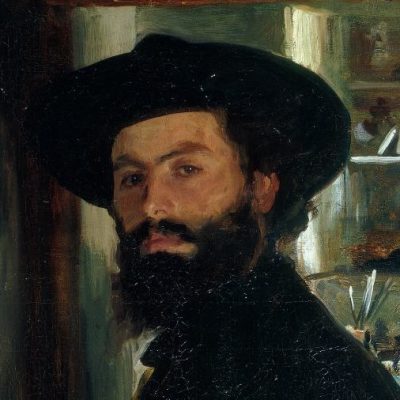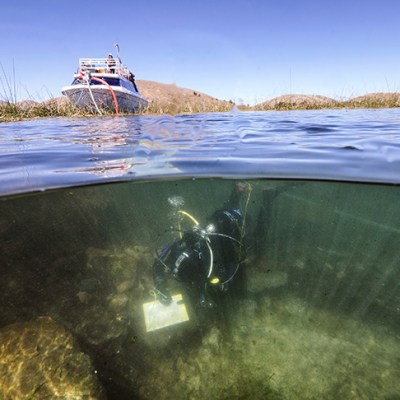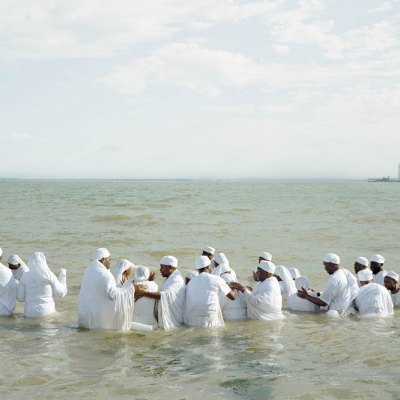About 50 years ago, the painter Reinhard Behrens was walking on the shore of Langeness, a watery place in Frisia. He came upon a rusted toy submarine – as he picked it up he got a start: a crab was living in it. He took the object home. A year later, while suffering delirium from sunstroke in Turkey, he saw a newspaper photograph of a cargo ship wrecked in a collision with a submarine. The name of the vessel: Naboland.
Since these two fortuitous events, Naboland has been the realm, the entire world, explored by the little submarine. Behrens is witness to its adventures. As he puts it, he has been trying to explain Naboland to the rest of us, to assert its existence.
But with Behrens there is always something new: we have never got to know the little tin pilot of this little tin sub so well as now. In the past he usually presented an obscured or impassive face, the well-known face of painted people on tin toys. Now he seems freer to react. In Shangri-La Express the submarine has been strapped to a yak, which is making its way along a snowy Himalayan ridge. Our pilot has a look of resignation.
The Croatian Holiday (2021), Reinhard Behrens. Courtesy Open Eye Gallery; © the artist
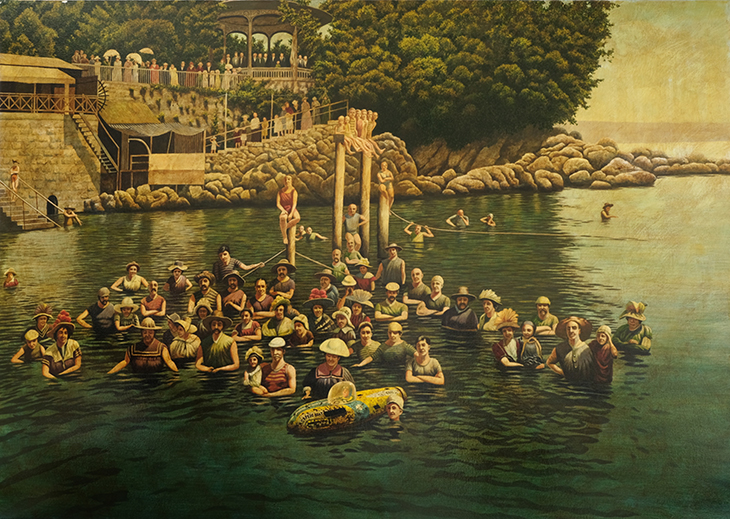
In The Croatian Holiday, a magnificent group portrait, the sub floats placidly among antique bathers, some in the striped swimming costumes of 1900. They face us as if waiting to have their photograph taken, several women cradling the submarine fondly. A man is coming down some steps into the water, pulling on his bathing suit, as though he’s just realised something interesting is happening. And it is. The pilot wears an expression of ironic tolerance (however, in an accompanying etching of the same scene he looks a little less happy – long day perhaps?).
The submarine surfaces in Venice, in a colourful acrylic and oil called Too Late for the Biennale (Behrens’s titles are priceless). Here the pilot looks cautious, taking care to avoid damaging any palazzos and to guide his ship through a canal crowded with bigger boats, beneath laundry hanging out to dry. Dive! Dive!
The submarine is, OK, phallic – an alter ego probe of maleness and the macho activities of adventure, exploration; but this is one of the kindlier phalluses in art. At the same time it is madeleine-shaped (part of it a pleasing yellow), giving us a hint of Proust and the bittersweet qualities of memory. It has also been known to fly, and invade paintings by Brueghel and Memling.
Staycation 2021 (2021), Reinhard Behrens. Courtesy Open Eye Gallery; © the artist

A painting not in this show has the sub swimming among virions of Covid-19. Lockdown has proved a productive time for Behrens, who paints in a fishing village in Fife. In Staycation 2021, the sub floats calmly in a loch, at the feet of a group of Highland cattle. It’s a very good example of Behrens’s skill with water, whether limpid, agitated, or frozen. And his rendering of the exact patterns of ‘Hielan’ Coo’ shagginess is a wonder.
In Arctic Awkwardness the sub has been tied to a group of reindeer who are just standing about, not helping it to get on, as if the pilot’s been duped by some local who assured him the reindeer would pull, then vanished with his fee. In the distance is an intricate tree line – Behrens is, among many other things, a striking landscape painter.
Into the Unknown is an arresting, nearly three-metre-wide Arctic seascape. The little submarine is steaming away from us, with what can only be described as a definite feeling of bravery. How Behrens manages to get such dramatic purpose into this faithful little tin toy is mystifying and enrapturing.
Dangers of Sledge-Travelling (2021), Reinhard Behrens. Courtesy Openeye Gallery; © the artist
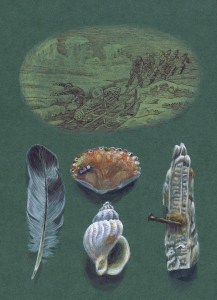
Under this painting is hung a series of small watercolours, painted on green card (vintage file folders). Each depicts a different polar adventure of the submarine, drawn in the forbidding style of the 19th-century literature of travel. The sub in the dangerous arctic: there are tunnels, conflict, gloom – one thinks of the original illustrations by Édouard Riou for Jules Verne. Beneath each vignette is a selection of trompe l’oeil detritus as from an explorer’s bag: feathers, limpets, bits of sea-glass, crab shells, the bleached jawbone of some long-dead beast. The titles evoke the era when the world was there to be conquered: In the Frozen Seas, Ice Barrier, Walrus, and The Dangers of Sledge-Travelling, in which a gang of men in fur hoods and mukluks have to drag the little sub up a chaos of ice.
‘Short Autumn Breaks to Naboland’ – a wonderfully satiric, tourist-boardy title – is the most complete documentation we yet have of the little tin submarine and its doughty confrontation with the world. But this diverting, meticulous, witty exhibition might also have been called ‘20,000 Leagues Under the Behrens Sea’.
‘Short Autumn Breaks to Naboland’ at Open Eye Gallery in Edinburgh until 23rd October.

